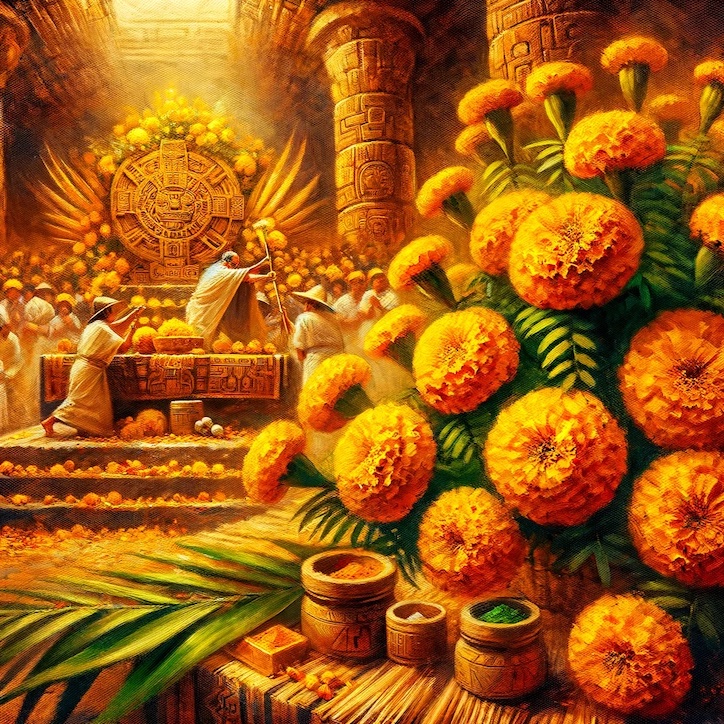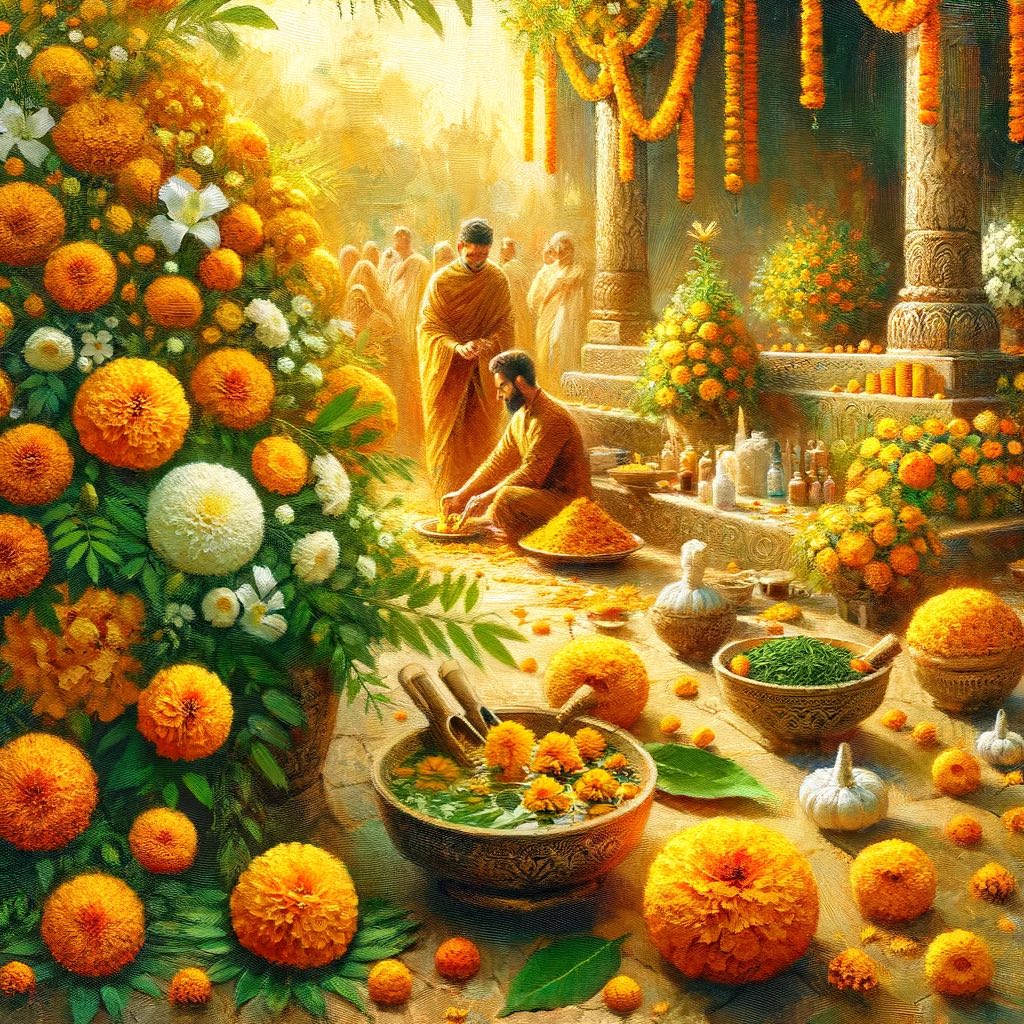Marigold history traces back to ancient civilizations where Tagetes, commonly known as Marigold, held significant ethnobotanical and ethnopharmacological importance.[1]https://pubmed.ncbi.nlm.nih.gov/32112898/
These bright, vibrant flowers are more than just an aesthetic delight; they have been deeply rooted in cultural traditions, religious ceremonies, and medicinal practices worldwide. From the Aztecs to modern herbalists, Marigolds have been cultivated and revered for their potent properties and symbolic meanings.
In this article we delve into the rich tradition of Marigolds and explore their multifaceted role across various countries and cultures.
Marigold History Throughout the World
Marigold Tradition in Aztec Culture
The use of Marigold in Aztec culture was extensive, with the flowers being used for religious, medicinal, and ceremonial purposes. The Aztecs believed marigolds possessed spiritual significance, using them in rituals to honor the dead, as well as to promote healing and protection.
Religious Significance
Marigolds were integral to the Aztec religious rituals. They were often placed on altars dedicated to the gods and used to decorate temples and sacred spaces.
Medicinal Uses
In traditional Aztec medicine, Marigolds were prescribed for their healing properties. They were used to treat various ailments, including cuts, burns, and various illnesses, demonstrating their role in ethnopharmacology.

Marigold Use in India
In India, Marigolds are synonymous with auspiciousness and are a staple in Hindu rituals and celebrations.
Cultural and Religious Ceremonies
Marigolds are widely used in Indian weddings and religious events. Their vibrant color is believed to bring good fortune and positivity to any occasion.
Ayurvedic Practices
Ayurveda, the ancient Indian system of medicine, recognizes Marigolds for their antiseptic and anti-inflammatory properties, using them to concoct remedies for skin irritations and infections.

European Marigold Folklore
Europe’s interaction with Marigolds began during the early trade routes but quickly became entrenched in local folklore and healing traditions.
Symbolism and Beliefs
In European folklore, Marigolds were believed to possess protective qualities, warding off evil and bringing good luck to those who planted them in their gardens.
Traditional Remedies
European herbalists valued Marigolds for their therapeutic benefits, using them in tinctures and ointments to treat a range of conditions from fever to bites and stings.

African Utilization of Marigolds
In African traditional medicine, Marigolds serve as a cure for many diseases and are used in spiritual practices.
Therapeutic Applications
Marigolds are used in Africa to treat wounds and as an antiseptic. They are also used to manage symptoms of colds and infections.
Spiritual Uses
The spiritual use of Marigolds in Africa often involves protection and divination, illustrating the flower’s deep-rooted significance in African culture.

American and Caribbean Practices
Marigolds have traveled to the Americas and the Caribbean, where they have been assimilated into local practices.
Home Remedies
In the Caribbean, Marigolds are commonly used in home remedies for their anti-inflammatory properties, providing relief from muscle aches and pains.
Celebratory Decorations
In the Americas, particularly in Mexico, Marigolds are iconic in the celebration of Día de los Muertos, where they are used to decorate altars and gravesites, symbolizing the vibrancy of life and the solemnity of remembrance.

Marigold history exhibits a rich tapestry of uses that transcend aesthetic appeal, illustrating a deep connection between people, plants, and their environment. As an embodiment of beauty and utility, Marigolds continue to be a subject of interest for ethnobotanists and pharmacologists alike, providing a living link to our cultural and medicinal heritage.
See Marigold benefits for details on many of these traditional medicinal and cultural uses, and also this one on Marigold as Insecticide.
I’m LeAura Alderson, a garden, herb and plant enthusiast with a passion for discovering the many edible and medicinal benefits of the plants all around us, including the weeds! I’m a writer, editor and media publisher for our family of websites.
While I was certified in fitness and life coaching, I am NOT a health practitioner. However, I’m a lifelong health enthusiast, with a keen interest in healthy, organic foods and making home remedies and the content we share is from our own experience and usage as well as that extracted from scientific research so that you can explore further on your own.
Always seek the advice and guidance of your health practitioners first and foremost.
As a family we’re steadily expanding our gardening, experimentation and knowledge around all things gardening, edible landscaping, fresh organic foods and self sustainability with farming in our future. I also own and manage iCreateDaily.com, a site all about transformation through creation, and the power of positivity, optimism and mindset.
References
| ↑1 | https://pubmed.ncbi.nlm.nih.gov/32112898/ |
|---|

